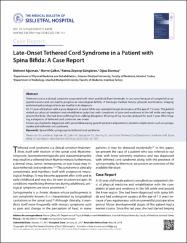Late-onset tethered cord syndrome in a patient with spina bifida: A case report

Göster/
Erişim
info:eu-repo/semantics/openAccessAttribution-NonCommercial 4.0 Internationalhttps://creativecommons.org/licenses/by-nc/4.0/Tarih
2018Üst veri
Tüm öğe kaydını gösterKünye
Ağırman, M., Çalkın, M., Güngören, F. Z. ve Durmuş, O. (2018). Late-onset tethered cord syndrome in a patient with spina bifida: A case report. Medical Bulletin of Sisli Etfal Hospital, 52(2), 138-141. https://dx.doi.org/10.14744/SEMB.2017.64936Özet
Tethered cord is a clinical syndrome associated with short and thick filum terminale. It can occur because of congenital or acquired reasons and can lead to progressive neurological deficits. A thorough medical history, physcial examination, imaging, and electrophysiological tests are heplful in its diagnosis. An 11-year-old patient with a prior diagnosis of spina bifida was operated for pes ekinovarus at the age of 1.5 years. The patient visited our physical medicine and rehabilitation polyclinic with complaints of pain and weakness in the left ankle and region around the knee. She had been suffering from walking disruption, thinning of leg muscles, and pain for past 1 year. After imaging, a diagnosis of tethered cord syndrome was made. Follow-up of patients diagnosed with spina bifida during growth period is important to prevent complications such as syringomyelia and tethered cord syndrome.


















